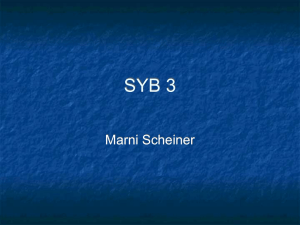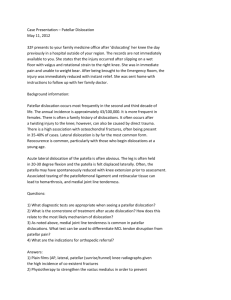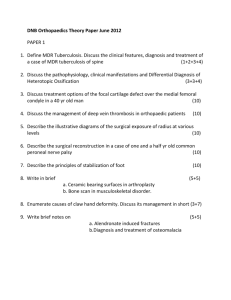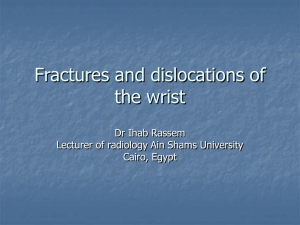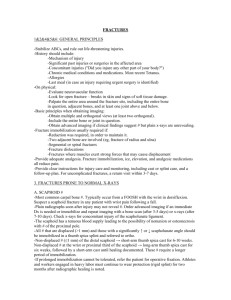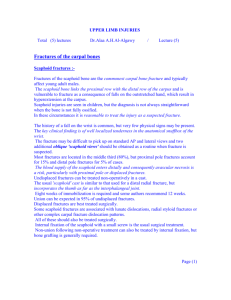Scaphoid Fractures CM Edits
advertisement
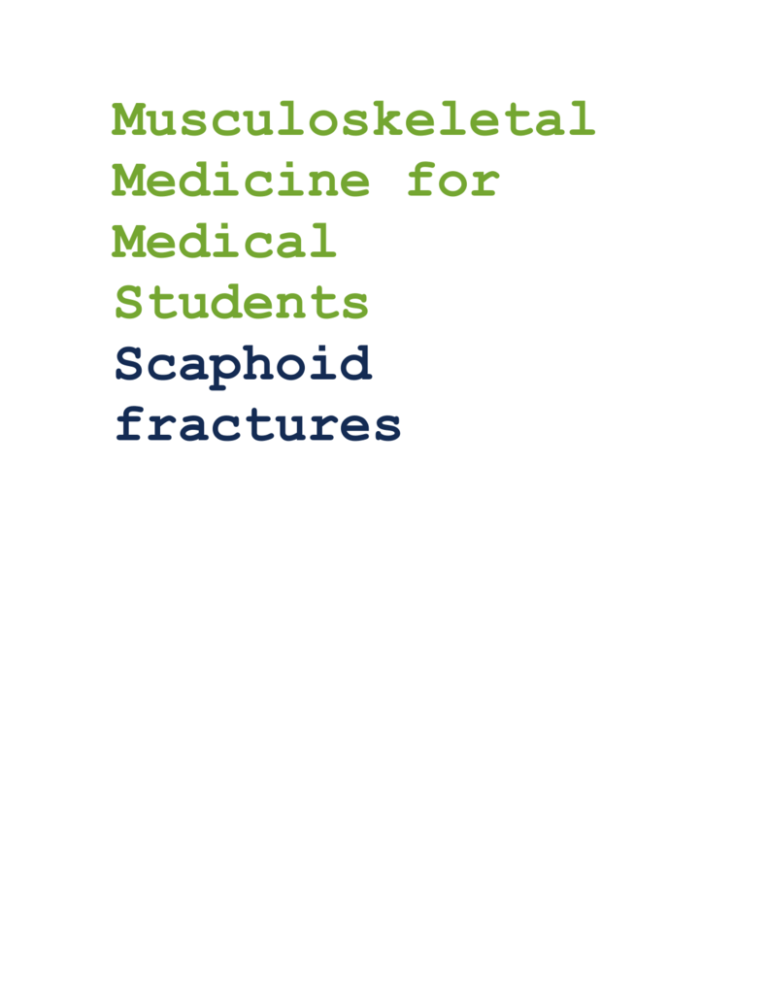
Musculoskeletal Medicine for Medical Students Scaphoid fractures Table of Contents 1 Description 3 2 Anatomy 4 3 Epidemiology of Scaphoid Fractures 5 4 Patient Presentation 6 5 Imaging 7 6 Differential Diagnosis 8 7 Treatment Options 9 8 Complications 10 9 Prevention 11 10 Miscellany 12 11 Key Terms 13 12 Skills 14 Scaphoid fractures 1. Description The scaphoid (also known as the carpal navicular) is perhaps the most important of the eight carpal bones: it is positioned in both the “proximal row” (carpal bones closest to the radius and ulna) and the “distal row” (carpal bones articulating with the metacarpals). Owing to its tenuous blood supply, the scaphoid is particularly susceptible to osteonecrosis (and ensuing post-traumatic arthrosis) after fracture. Unfortunately, the scaphoid is also the most commonly fractured of the eight carpal bones. Fracture is usually caused by a fall on an outstretched hand (a mechanism also associated with distal radius fractures and radial head fractures). 2. Anatomy The scaphoid can be morphologically divided into three anatomic regions: proximal third (proximal pole), central third (waist), and distal third (distal pole). A tuberosity on the distal palmar aspect serves as an attachment site for the transverse carpal ligament. 65% of fractures occur at the waist, 15% at the proximal pole, 10% at the distal pole, and 8% at the tuberosity. figure of AP xray showing normal scaphoid 80% of the scaphoid is covered with articular cartilage; it articulates with the radius and four carpal bones (lunate, trapezium, trapezoid, and capitate). The scaphoid rests on the radioscapholunate ligament which stabilizes the scapholunate articulation and acts as a neurovascular conduit. The scaphoid does not have any tendinous attachments. The scaphoid receives its primary blood supply from the dorsal scaphoid branches of the radial artery, which enter the scaphoid at a point near the distal pole. As such, the scaphoid is perfused in the distal to proximal direction ("retrograde blood supply"). drawing of scaphoid blood supply? Because of this retrograde blood supply, an injury to the scaphoid waist (ie the middle third of the bone) can interrupt blood supply to the proximal pole. (This is analogous to femoral neck fractures and resulting femoral head ischemia: just as the vessels to the femoral head must traverse the femoral neck, the blood supply to the proximal pole of the scaphoid must traverse the waist). 3. Epidemiology of Scaphoid Fractures The scaphoid is the most commonly fractured carpal bone (60-70%). Fractures of the scaphoid often occur in active individuals, and have two to four times greater incidence in men than woman. Active men aged 20-30 are most likely to suffer a scaphoid fracture. Scaphoid fractures are uncommon in children and the elderly, due to the relative weakness of the distal radius compared to the scaphoid in this patient population. The most common mechanism of injury is a fall onto an outstretched hand with forced dorsiflexion, ulnar deviation, and intercarpal supination. The true incidence of scaphoid fractures has been difficult to quantify particularly because many of these injuries are undiagnosed. One estimate is that scaphoid fractures occur in 1 out of 100,000 people per year. 4. Patient Presentation Patients with scaphoid fractures will often present with radial sided wrist pain (worsened with gripping or squeezing), variable swelling and limited range of motion. Because scaphoid fractures may occur without bruising or visible deformity, patients may assume a less serious injury and delay seeking evaluation. During examination, it is important to always compare the injured to the uninjured wrist. Check if patients have: 1. Tenderness to palpation of the "anatomic snuffbox." The anatomic snuffbox is located in a triangle formed by the extensor pollicis longus tendon, abductor pollicis longus tendon, and the radial styloid. It can be found more easily when the thumb is actively extended. Anatomic snuffbox pain has a sensitivity of 90% and specificity of 40% for detection of scaphoid fractures. clinical photo of surface anatomy of anatomic snuff box 2. Tenderness to palpation over the scaphoid tubercle. The scaphoid tubercle can be localized on the volar aspect of the wrist. Pain to palpation has a sensitivity of 87% and specificity of 57% for detection of scaphoid fractures. 3. Pain with axial compression of the thumb: the scaphoid compression test. According to the initial description, the scaphoid compression test "has the advantage that it can be done when the patient is in a plaster cast." However, this test is less sensitive (70.5%) and specific (21.8%) than direct palpation of the anatomic snuffbox or scaphoid tubercle. Red flags that should raise suspicion for a scaphoid fracture include: a fall on the outstretched hand, and pain in the anatomic snuffbox. 5. Imaging Plain radiographs are essential for all patients with suspected scaphoid fractures. Standard radiographs include anteroposterior (AP), lateral, oblique and scaphoid views. The scaphoid view is a posteroanterior (PA) view of the wrist, with the wrist positioned in ulnar deviation, pronated obliquely at 45 degrees, and at 45 degrees of ulnar elevation. xray showing displaced scaphoid fx I think it would actually be really helpful to see a “scaphoid view” x-ray. Maintaining a high index of suspicion based on the clinical picture is important, as initial radiographs of a scaphoid fracture may be normal. An MRI should be used to detect suspected occult scaphoid fractures when patients present with pain in the anatomic snuffbox following a fall on the outstretched hand. mri showing occult scaphoid fx Although bone scans (scintigraphy) can also be used to detect occult scaphoid fractures, MRI has two advantages: 1. It can be used immediately (bone scans assess a biological reaction that takes days to mount, and thus can be falsely negative in the first few days) 2. It can detect ligamentous injuries as well (Note: although an MRI is an "advanced imaging modality" and in some venues is still expensive, it is also expensive to fashion a spica cast and perform repeat radiographs--not to mention the hassle imposed on the patient wearing a cast that may have been unnecessary.) CT Scans and MRIs may also be used as an adjunct to plain films, to better assess fracture configuration or displacement. 6. Differential Diagnosis The differential diagnosis of suspected scaphoid fracture includes: • Radial styloid fracture. Here, the tenderness is more proximal; radiographs should make the diagnosis • Distal radius fracture. Tenderness localizes to distal radius and deformity may be present; radiographs should make the diagnosis • Scapholunate instability. In this condition, the tenderness is more toward the ulnar side of the hand (over scapholunate ligament) and radiographs should show a gap between scaphoid and lunate (scapholunate disassociation). • Flexor Carpi Radialis tendon injury. This can be diagnosed by noting pain elicited with resisted wrist extension. • De Quervain Disease. A positive Finkelstein's test may help make the diagnosis. • Carpometacarpal Joint Arthritis. Here, radiographs should make the diagnosis; but recall that a patient with arthritis can suffer a superimposed injury. As noted, fracture of the scaphoid is usually caused by a fall on an outstretched hand, the same mechanism associated with distal radius fractures and radial head fractures. The astute clinician must be mindful of these potentially associated injuries. 7. Treatment Options Anatomic snuffbox pain following a fall on an outstretched hand should be assumed to be a scaphoid fracture, even if initial radiographs appear negative. The patient's arm should be immobilized in a non-removable thumb spica splint. Repeat radiographs should be performed 1-2 weeks after the injury. This approach will minimize the chance that an occult fracture (ie, one not seen on x-ray) that is initially non-displaced becomes a displaced fracture (with a greater risk, in turn, of disrupting the blood supply). Non-displaced fractures are defined as fractures with less than 2mm of displacement and no fracture site angulation. These types of fractures are treated by immobilization in a long or short arm thumb spica cast for 6 weeks. (The inclusion of the thumb is advised; whether a long arm or short arm cast is needed is more controversial. Including the elbow will minimize pronation/supination.) clinical phone of thumb spica splint to temporarily immobilize the scaphoid while awaiting definitive treatment Expected times to scaphoid fracture union following immobilization depend on the location of the fracture: Distal third, 6-8 weeks; Middle third, 8-12 weeks; Proximal third, 12-24 weeks. A small (n=25) prospective, randomized study comparing cast immobilization with percutaneous cannulated screw fixation of nondisplaced scaphoid fractures found that screw fixation resulted in faster radiographic union (7 weeks vs 12) and return to military duty (8 weeks vs 15). Comminuted, displaced or unstable scaphoid fractures benefit from surgical fixation. Indications for surgery include: fracture displacement >1mm, radiolunate angle >15 degrees, scapholunate angle >60 degrees, scaphoid flexion deformity, or nonunion. The favored technique is open reduction internal fixation with K-wires and screws. The choice of fixation depends on a multitude of factors, such as the location of the fracture, configuration of the fracture, functional concerns, and patient factors. xray of scaphoid orif Regardless of length of immobilization after a scaphoid fracture, appropriate physical and occupational therapy is needed after removal of the cast or splint to optimize range of motion and function. 8. Complications 1. Nonunion Radiographic signs of nonunion include sclerosis, cyst formation, and a flexion (“humpback”) deformity of the scaphoid. Most scaphoid fractures treated nonsurgically heal without difficulty, with the occurrence of nonunion reported between 5% and 15%. Smoking is strongly associated with nonunion after surgical fixation of the scaphoid. 2. Avascular necrosis As discussed above, a more proximal fracture location or the presence of fracture displacement increases the risk of avascular necrosis of the proximal scaphoid (due to retrograde blood supply). 3. Post-traumatic arthritis Scaphoid fractures are under-recognized and under-treated; it is not uncommon for patients to become aware of a scaphoid fracture months or years after the injury, once arthritis has developed. Changes in carpal mechanics as a result of nonunion, avascular necrosis, and collapse leads to a pattern of articular degeneration of the wrist termed SNAC (scaphoid nonunion advanced collapse). Once arthritis is evident at the radiocarpal joint, there are salvage surgical procedures that can be performed. These include a proximal row carpectomy, scaphoid excision and midcarpal arthrodesis, or a total wrist arthrodesis. 9. Prevention Short of telling all young, active males to not fall (and getting them to comply!), it is difficult to prevent scaphoid fractures. Prevention of complications can be achieved by early recognition and definitive treatment, including preventing non-displaced fractures from displacing. 10. Miscellany Scaphoid derives from the Greek word skaphos, which means “a boat.” The English word "skiff" has a similar origin. The scaphoid is also referred to as the carpal navicular (coming from navis, the Latin word for "boat,” from which we get the English word "navy"). Given that there is also a boat-like bone in the foot, it is probably best to refer to the bone in the hand as the scaphoid and the one in the foot as the navicular. 11. Key Terms Scaphoid, fracture, nonunion, malunion, avascular necrosis, post-traumatic arthritis, anatomic snuffbox, scaphoid tubercle, scaphoid compression test 12. Skills Perform physical examination to recognize occult scaphoid fractures; be able to explain to patients why immobilization is needed despite “normal” x-rays; apply a thumb spica splint to temporarily immobilize the scaphoid while awaiting definitive treatment
